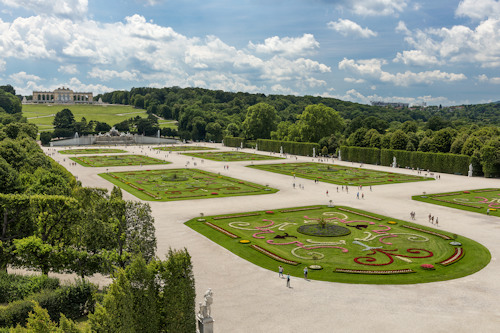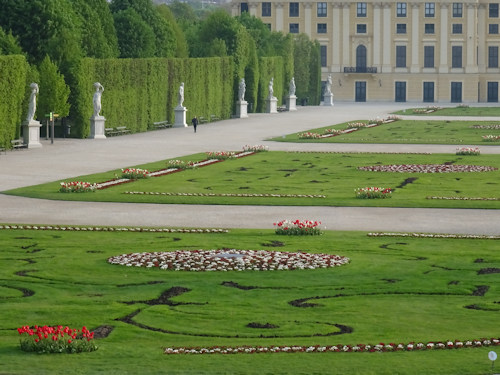
They tell us to take time to smell the roses. The parks and gardens at Schönbrunn offer the chance to do exactly that. Literally and figuratively…
- A glorious mix of woodland, park, topiary, flowering shrubs, rare plants, and landscaped flower displays (including roses)
- Nearly all of it is free to go around
- Red squirrels!
- An excellent place for a morning jog too
- Book a Schönbrunn concert, tour & more*
- See also:
What to expect

(Schloß Schönbrunn, Wien – part of the landscaped gardens in spring)
The park and gardens around Schloß Schönbrunn stretch across more than a square kilometre of city, with a mix of landscapes that echo the palace’s history:
- Avenues of trimmed hedges and geometric patterns laid out in flowers speak to the desire of various imperial residents for rest, recreation, and something to show off to the neighbours
- The woodland harks back to the days when Schönbrunn was a hunting lodge and also offers shade in hot summers (not to mention a hidden café)
- A botanic garden reflects the scientific bent of the 18th-century Emperor, Franz I. Stephan
All the areas mentioned have been open to the public for well over two centuries and still are: gates usually open at 6.30am with no charge to enter. You do have to pay, however, to go into the maze, and the enclosed Orangery and Kronprinzengarten gardens.
The park and gardens typically shut between 5.30pm and 9pm, depending on the season.
(Find tickets and experience options for the palace and zoo)
The early opening makes the area a lovely place for a morning run. The attractions (such as the palace tour) open later, so the grounds remain relatively empty at first with plenty of paths and space for joggers.
Equally, this means you can take people-free photos of the palace if you enter the gardens in that hour or two before the various locations and entertainments unlock their doors. (Incidentally, that’s one of my many tips for making the most of a Schönbrunn visit.)
Where to go
One side of the palace has the main gardens stretching away in front of it. But if you want to explore a little more, here’s the route I took on my most recent visit:
(Words in bold feature as landmarks on the map above.)
Assuming you enter the Schönbrunn complex via the main entrance, head toward the palace and veer off right to go through the arch and around to the side of the building.
This takes you to one end of the Kammergarten, a lovely little series of flowerbeds, topiary and box hedges. Look for the two long trellis tunnels, one covered in Wisteria, the other in climbing roses. Both shimmer with colour when in full bloom.
Walk through the Kammergarten, away from Schönbrunn Palace, and on to parkland with flowering shrubs and ornamental trees, including a magnificent copper beech.
That’s where you turn left to move across the huge tree-lined avenue, under beech archways, to eventually reach a ring of perfectly-pruned lime trees surrounding a large rose garden.

(The great parterre of Schönbrunn palace; press photo © Schloß Schönbrunn Kultur- und Betriebsges.m.b.H., Alexander Eugen Koller)
Then circle back to continue through the parkland with its enormous plane trees and around to the Hietzinger Tor park entrance.
From here you wander down the path around the edge of the park, past the Palmenhaus (Palm House) with another collection of sculpted flowerbeds, ornamental hedges and topiary, past the desert house, and on to the zoo. Here you go right.
Walk on through the botanic garden to its end up a slope.
Various resplendent trees and shrubs mark the path, including a huge English oak, a Ginkgo tree, giant reeds, a delicate Japanese maple, a gorgeous Bald cypress, flower meadows, an ochre Scot’s pine, and much more.
At the top exit from the botanic garden, take the fairly steep climb up to the Tirolergarten restaurant and continue along the avenue to the Gloriette. This takes you through mixed woodland, with the chatter of birds to accompany you.
From the Gloriette, walk down the hill toward the palace, enjoying the excellent vistas, and cross behind the Neptunbrunnen (Neptune Fountain); peek through the grotto for another stunning view of the palace and main gardens.

(Schloß Schönbrunn, Wien – the main gardens in early spring)
From there, walk up the long, level avenue that heads east and runs parallel to the fountain. Pass the (old, but fake) Roman Ruins and reach the Obelisk.
From the obelisk, go back down the tree-lined avenue that ends in the palace until you reach a small fountain and pond.
That avenue is actually known as the Obeliskenallee and makes an appearance in the movie Corsage, which dramatises a short period in the life of Empress Elisabeth.
Cross from the fountain to enjoy the geometric masterpieces in colour that are the main gardens before returning to the palace building. (Those gardens also appear in Corsage.)
All-in-all it’s about a 4km walk on decent paths but with some slopes. If you want to stay on the flat, turn left at the zoo (not right) and follow the zoo’s outskirts until you reach the Neptune Fountain.
And keep your eyes open for excessively-cute red squirrels at all times: they’re not shy of showing themselves, even in winter.
How to get to Schönbrunn Park
Check the travel page for tips and directions for reaching the palace.
Address: Schloß Schönbrunn, 1130 Vienna